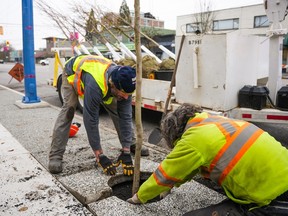Vancouver aiming to grow urban forest canopy but don’t expect the promised 100,000 new trees soon
HOME BUYERS – To get the best exclusive listings visit www.vreg.ca and go to “EXCLUSIVE DEALS”
Vancouver’s “greenest” city plan, approved in 2011 by the city’s then Vision-Vancouver-majority government, set a target of planting 150,000 trees by 2020. According to a 2020 city presentation, 139,000 trees were planted by that deadline — an average of almost 13,900 a year, far more than the recent pace.
Vancouver staff said Wednesday that the city’s focus will be not on the number of trees planted, or the number added, but on the percentage of the city’s land mass protected by tree canopy.
ABC Coun. Sarah Kirby-Yung said she understands the shift to focus on canopy percentage over tree numbers. But she asked staff whether the target of 30 per cent could be higher, or it could be achieved sooner than 2050, considering that canopy cover increased from 21 per cent in 2013 to 25 per cent in 2022.
Joe McLeod, Vancouver’s associate director of urban forestry, responded: “I think the last five per cent of this goal is going to be a lot harder.”

A similar pattern plays out across the region. A 2021 analysis by Postmedia journalist Nathan Griffiths found that wealthier neighbourhoods were significantly cooler than their lower-income neighbours who were surrounded by more concrete and roads, and fewer trees.
It can be more difficult — and expensive — to plant trees in these “very urbanized environments,” McLeod told council.
Removing pavement and excavating to create a new tree pit can cost as much as $20,000, he said.
He cited the 700-block of East Hastings as an example where the city has recently been able to add several new trees to a tree-deficient area.
ABC Coun. Mike Klassen proposed directing staff to explore innovative ways to reduce urban heat islands in neighbourhoods with less tree canopy cover, including areas where it is challenging to grow trees.
Klassen’s proposal, which council supported, mentioned the example of “vegetated shade structures.” These are roughly four-metre-long sail-shaped awnings covered in vegetation, which are designed by a Spanish company and have been installed above urban streetscapes in Spain, England and Turkey.
Asked whether ABC’s 100,000-tree campaign promise was unrealistic, Klassen said: “I’ll never apologize for being ambitious.”
“I think all innovative solutions have to be brought to bear,” he said. “What’s our goal? Our goal is to create cooler conditions in the face of a changing climate, and we’re using whatever tools are at our disposal to achieve that.”




